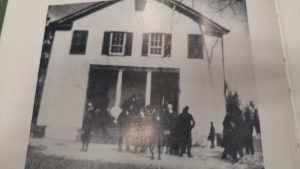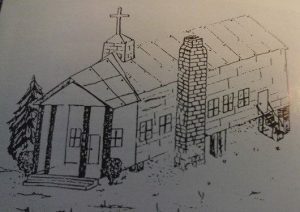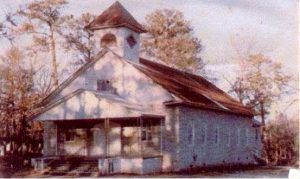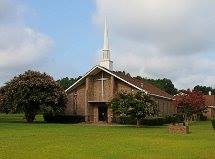



Historical Sketch of
New Light Beulah Baptist Church,
Hopkins, SC
(April 26th, 1806 — November 1867) — (December 1867 July 1st, 2017)
New Light Beulah Baptist emerged as an independent Black congregation in December of 1867 after virtually every Caucasian member of Beulah Baptist ceased attending with the one exception of Deacon John D. Smith, clerk of the church. Several reasons contributed to the exodus of the White members. Firstly, many of the White members left in 1858 organizing St. John Episcopal Church of Eastover while Reverend W. D. Beverly was still pastor of Beulah. Around this period of time Beulah reported 18 White and 294 Black members. The emergence of the Civil War likewise caused a drop in the White membership. Immediately following the Civil War Federal troops destroyed the South Carolina Railroad that lead from Columbia to Lower Richland which hampered Beulah’s pastor Reverend James Lawrence Reynolds traveling from Columbia to Beulah Baptist in Grovewood (now Congaree/Hopkins/Eastover) as it was called then. The difficulty experienced by Reverend Reynolds resulted in his resignation as pastor of Beulah in December of 1865 and his acceptance as pastor of Columbia’s First Baptist Church. Prior to his resignation Reverend James Lawrence Reynolds ordained three African-Americans to the Gospel Ministry. November 12th, 1865, Pastor Reynolds ordained Brothers Charles Moye, William Adams and William. Weston Adams as Ministers of the Gospel to assist in the ministry to the Black members of Beulah.
Shortly after Pastor James Lawrence Reynolds departed, the handful of White members called Reverend Charles A. Stiles to lead them on the first and third Sundays. Reverend Stiles attempted to revive the White membership of Beulah Baptist but failed. Reverend Stiles and the small White congregation still exercised control over the larger Black congregation lead by Reverend William Weston Adams who was allowed to preach on the Second and Fourth Sundays. Commencing during the period between August and December of 1867, Beulah’s White members dispersed and stopped attending the church. The two groups continued to share the same sanctuary until December 1867. Beulah’s Black members assumed independent rule when Reverend Stiles ceased serving as Pastor before the end of 1867. The last White member and church clerk Deacon John D. Smith recorded his final minutes on Saturday, April 11th, 1868 before leaving Beulah. Portions of Deacon Smith’s recording can be found in the minutes of Beulah Baptist in the Special Baptist Collection at Furman University. Deacon Smith’s departure represented the last White member of Beulah/New Light Beulah Baptist Church which had been organized sixty one years earlier on April 26th, 1806 out of Congaree Baptist Church. Beulah Baptist experienced a ten year lapse before it was reorganized by the Fairfield Baptist Association between 1877 and 1878. Due to the birth, death and resurrection of Beulah Baptist, it is often referred to as a Phoenix.
Beulah from its inception had thirteen pastors up to 1867. They included Reverends Amos Dubose, the first pastor; Isaac Tucker (1810-1811); George Scott (13 year tenure); Charles Dutton Mallary (builder of first sanctuary); Robert Missilldine (1 year tenure); James and Samuel Furman (relatives of ‘well-known Reverend Richard Furman); W. Holmes (1841-1849); Thomas Adams (the ninth pastor); James Lawrence Reynold (first term as pastor and President of the South Carolina Baptist Convention); William D. Beverly (11th Pastor); James Lawrence Reynolds (second term as pastor and ordained first African-American ministers); and Charles A. Stiles (the last White Pastor of New Light Beulah (formerly Beulah Baptist). During this era New Light Beulah (formerly Beulah) ordained it first Black Deacons on October X7,1810. Those Deacons included Humphrey Howell Alex Hail, Joe Roach and Bob Weston. The following year on April 20th, Joe Hopkins was ordained as a deacon. February 25th, 1827 Brethren William and Primus Adams were ordained as Deacons. During 1829, Beulah divided the Black congregation into seven wards and assigned Deacons accordingly, Ward 1 Primus and Mill Adams; Ward 2 Charles Moye, Peter and Ned Hopkins; Ward 3 Robin Adams and Hampton Goodwin; Ward 4 York Reese; Ward 5 Humphrey Howell; Ward 6 Adam Chappell; and Ward 7 Lew Partridge. Deacons Ned and Peter Hopkins attempted to preach the Gospel without having been licensed and were charged with preaching without license and silenced on July 28th, 1833. These spiritual leaders and the African-Americans members of Beulah continued to worship in this church as slaves until freed with the invasion of the Union Army in February of 1865. One year later on May 14, 1866 several individuals withdrew from New Light Beulah (formerly Beulah) organizing Shiloh Baptist Church, Weston, SC.
Reverend William Weston Adams assumed the pastorate of New Light Beulah (formerly Beulah Baptist) in late 1867 when the Black members were abandoned and left to themselves and begin to rule themselves independently. Spiritual leaders assisting Reverend William W. Adams included Preston Richardson, John Dinkins, Ned Edward Middleton, Pharaoh Smith, Lewis Tucker, Charles Howell, Robert Jones, Paul Sims and James Taylor. George Washington Taylor, the son of James Taylor was appointed as the first African-American church clerk.
New Light Beulah’s membership was greatly diminished in 1871 when a vast majority of the members left to organize Zion Benevolent Baptist Church. Most of these members had been slaves on Joel Adams’ Elm Savannah Plantation. Years after the White members ceased using the sanctuary, questions about legal ownership of the church property began. The members of the New Light Beulah claimed ownership, as well as the former white members of Beulah Baptist Church. The continuing dispute and the distance traveled by some members resulted in more than half of the membership securing letters of dismission in 1871 to organize the Zion Benevolent Baptist Church, Hopkins, S. C. Complicating the issue of ownership even more was a dispute between Anthony Morris (Black), a member of New Light Beulah and Jesse Reese (White), a former member of Beulah Baptist Church. December 2, 1871, apparently Brother Anthony Morris purchased a cow from Mr. Reese for $34.00 placing $21.00 down with a promise of possession with payment of the balance. Brother Morris later came prepared to pay the balance, but was told by Mr. Reese that the cow was sold and there would be no refund. Consequently, conflict arose between Reese and Morris, along with several members of the New Light Beulah Baptist Church who supported Morris. Subsequently, one of Mr. Reese’s cows was maimed resulting in accusations of several New Light Beulah members who were eventually tried in General Sessions Court. Tense relationships developed in the Grovewood-Congaree community between Black and White citizens.
Animosity within the community intensified when Mr. Jesse Reese’s nephew Jesse Reese Adams, kilt/bite half-brother of Reverend William W. Adams, in 1873 moved himself and family into the sanctuary previously shared by Beulah and New Light Beulah. This was the same sanctuary that was being used by the Black members of New Light Beulah Baptist at that time. The following Sunday when New Light Beulah members arrived for worship, they found Jesse Reese Adams armed and were forced to leave the premises. The land that the sanctuary sat on was originally purchased from the Reese family in 1832.
Pastor William W. Adams and the New Light Beulah Baptist congregation decided to build a bush arbor on land of Deacon Pharaoh Smith. Deacon Smith’s land was rented from the Reese family. Shortly after the bush arbor was built, another segment of New Light Beulah Baptist opted to withdraw to form a new church. In 1873 Zion Pilgrim, Hopkins became the third church organized out of New Light Beulah Baptist. Zion Pilgrim called Reverend Jonas Ancrum, the pastor of Red Hill Baptist, as her first pastor. It was during this same year of 1873 during Reverend Adams’ pastorate that the Sunday School was organized with Deacon Preston Richardson serving as first Superintendent.
Strained relationships within the neighboring community prompted New Light Beulah members to no longer consider themselves as members of the Fairfield Baptist Association. Pastor William W. Adams and the Leadership of New light Beulah affiliated with the Gethsemane Baptist Association, Upper Division in 1873. Delegates to the Association included Pastor Adams and the church clerk Brother George Washington Taylor. Taylor reported 154 members having been affiliated with the church that year.
Pastor Adams resigned in 1875. St. John of Hopkins and St Matthew of Eastover were organized out of New Light Beulah in 1875 after Reverend Adams left. The church elected Daniel Boyd, a former slave of Robert Adams, as its second black pastor. During 1876, the Spirit of the Lord moved mightily on the church when 56 souls were baptized. it is believed that no other year in church history can match the number of converts made in 1876. Some 161 converts were made during the pastorate of Reverend Boyd. Brother George Washington Taylor, the church’s clerk was ordained as a missionary in 1880 during Reverend Boyd’s tenure as pastor. Taylor was appointed associational missionary during the same year. Brother Andrew Richbourg then assumed the role of church clerk. Richbourg reported the church’s membership at 556 in 1881. During that same year, the Sunday School had 120 scholars, four teachers and 120 books in its library. The church membership roll would have exceeded 600 members except for some disgruntled members who left to organize St. James Baptist Church without proper letters of dismissal. The Executive Board of the Pee Dee Association (formerly Gethsemane Association, II Division) of which Beulah was then a member instructed them to return to New Light Beulah Church. Those members refused to return to New Light Beulah and subsequently joined the newly formed Wateree Baptist Association in 1881. Other charter members of the Wateree Baptist Association included New Light Beulah and some 47 other churches. Reverend William W. Adams, New Light Beulah’s first African American pastor, served as St. James Baptist’s first pastor.
New Light Beulah’s membership dropped to 424 in 1881 because additional members transferred to St. James Baptist Church. With the organization of the St. James Church, it appeared that no other church would be formed out of New Light Beulah. However, thorny issues like the changing political climate and issues relating to constructing a new sanctuary caused a split in the congregation. Pastor Boyd, Deacons John Dinkins and Lewis Tucker left the church and illegally formed Siloam Baptist Church without proper letters of dismissals. The Executive Board of the Wateree Baptist Association instructed the members of Siloam to secure proper letters of dismissal and report back to them in 30 days. This was done, and Siloam was accepted as a member of the Wateree Baptist Association in 1885.
New Light Beulah elected Nazareth’s s Reverend Isom William Simons as her next pastor. Just prior to Reverend Simons’ arrival, the church had elected Brother Frank Smith as church clerk to replace Andrew Richbourg However, Brother Richbourg was re-elected church clerk in 1885 for I year. Burrell J. Goodson was elected church clerk in 1886. Isom Harrison Goodwin was then elected clerk in 1887. Frank. Smith served as clerk again in 1887 New Light Beulah’s church clerks Smith, Goodson and Goodwin were all at one time students of Benedict Institute.
Pastor Simons having been familiar with the Pee Dee Association while pastor of Nazareth Baptist recommended that New Light Beulah affiliate with the Pee Dee Baptist Association. In 1886 New Light Beulah began an 18-year affiliation with the Pee Dee Baptist Association before reaffiliating with the Wateree Baptist Association.
The church purchased two acres of land from the Kaminer brothers on December 26, 1886 for $25.00. Trustees signing the deed were Abram Weston, Jacob Gallman, Pompey Smith, Thomas Stocker, Warwick Howell, Hampton Jamison and Julius Goodwin. During the same year that the church purchased land, a small number of members withdrew to organize St. Peters Baptist of Eastover, SC now defunct. immediately afterward the land purchase, members of the congregation started construction on their new sanctuary. New Light Beulah’s new sanctuary was completed in 1889. Within two years, the Beulah school was completed. The Beulah School was constructed adjacent to the newly built church. Brother Spencer Adams was the first teacher at the Beulah School in 1891. Brother Adams was the son of Reverend William W. Adams, New Light Beulah’s first African-American pastor.
Pastor Isom William Simons resigned his pastorate in 1891. Shortly after the departure of Reverend Simons several members withdrew to organize Friendship Baptist under the leadership of Reverend Belton Goodwin. With Reverend Simons’ departure for Bethesda Baptist in Georgetown, S. C., New Light Beulah called Reverend George Washington Taylor her first Black church clerk as pastor. It was during the latter years of Reverend Taylor’s tenure as pastor that the church hosted its first associational meeting. New Light Beulah hosted the Twenty Sixth Annual Session of the Pee Dee Baptist Association. During the pastorate of Reverend Simons, Brother Ralph M. Myers joined New Light Beulah Baptist. He was later ordained and went on to organize Second Nazareth Baptist in Columbia and serve as the first Pastor of St. John Baptist of Columbia, SC. Reverend Myers also served as pastor of Macedonia Baptist Church now known as Gill Greek Baptist.
Andrew Richbourg assumed the pastorate in 1897 and served a relatively short time. Richbourg was a dynamic preacher and a leader in both the Pee Dee and Wateree Baptist Associations. Pastor Richbourg’s wife was Ms. Grace Hopkins, the daughter of Robert and Phyllis Hopkins, charter members of independent New Light Beulah Baptist Church. Pastor Richbourg served as pastor until 1899 when he resigned to serve another congregation.
New Light Beulah’s sixth Black pastor was Reverend Jesse William Neal. Pastor Neal was enthusiastically supported by the church and Deacons Preston Richardson, Burrell Goodson, George Tucker, Paul J. Taylor, English Hopkins, Sr., Frank Middleton and Moses Laney. Under Pastor Neal’s leadership the church grew spiritually and numerically. He served faithfully until 1909 when he tendered his resignation to accept another call. Pastor Neal was ordained in 1897 by the Wateree Baptist Association.
The Reverend John B. Barber succeeded Pastor Neal, He began his pastorate in 1909 and served for forty-eight years. It was during Pastor Barber’s tenure that disaster struck New Light Beulah Church. In 1916, a fire caused by a fallen stovepipe consumed the 28-year-old structure. Under Pastor Barber’s leadership, the church returned to the role of the “Mother Church” of lower Richland Black Baptist churches. in 1957, Pastor Barber became ill and resigned.
Immediately after Pastor Barber’s resignation, the Reverend Westberry H. Neal opened his pastorate at New Light Beulah Baptist. Under Reverend Neal’s leadership, the church continued to flourish. August 31st, 1969 Brothers Joel Adams, Pelham Myers, Joseph Hampton, Henry T. Hopkins, John Albert Middleton and Willie James Goodwin were ordained as Deacons. During his pastorate, the church voted to relocate and move north above the current location. New Light Beulah purchased 6 acres in 1978 to start construction on a new sanctuary. Upon 22 years of service, Dr. Neal submitted his resignation in 1978. The church elected Dr. Neal as Pastor Emeritus after his resignation. In its search for a new pastor, New g Beulah selected Reverend William C. Henderson as her next pastor. During Pastor Henderson’s tenure the church began tithing, worship service every Sunday and began construction on its new edifice. The new sanctuary was nearing completion when Dr. Henderson closed his pastorate in 1982.
The Reverend Lawrence Thomas David, a retired army chaplain, then accepted the call to the pastorate. January 4, 1982 was the date that Reverend David assumed his pastorate. Pastor David was installed on August 15, 1982. As pastor, Reverend David began to implement objectives to move the church forward. On May 23, 1982, Women’s Day, members proudly entered their new sanctuary, debt free and valued at more than $170,000.00. Shortly after moving into the new sanctuary, several ministries were initiated. Those ministries included orientation & disciple making classes, a bus service, child development program, meals on wheels, clothing bank, athletic league, tutorial program and the family ministry headed by Mrs. Henrietta Davis.
Through the leading and guidance of the Holy Spirit, the Children’s Ministry came into existence on January 5, 1986. Deacon John A. Middleton observed that the children needed additional spiritual training. They needed to be taught on their level because they were not relating to the message as presented from the pulpit. Therefore, Deacon Middleton presented numerous objectives relating to a children’s ministry under the direction of the Sunday School Department. These objectives were presented to Pastor Lawrence T. David and the Deacons for approval. Approved projects included the Children’ Ministry and a Bus Ministry, that were designed to work together.
Deacon Tally Adams, Jr., Superintendent of the Sunday School announced that he would be resigning June 26, 1984. Deacon John Allen Middleton acknowledge interest in the position. Deacon Middleton accepted the position of Superintendent and gave up the position of Young Adult Class teacher and Athletic Commissioner of the “Neighboring Christian Athletic Association”.
The church’s first constitution and by-laws were adopted on February 18, 1988. This document called for officers within the Board of Deacons, a church council, a kitchen committee, an educational society, church library and athletic department.
An additional 4500 square foot classroom wing was added during the pastorate of Reverend David. This wing was added to accommodate the Sunday School Department and expanded Child Care Development Center. This addition was dedicated on September 10, 1989. The church also completed its parking lot in September of 1990. The value of all church facilities exceeded more than a half million dollars by the end of 1990.
Pastor Lawrence T. David announced his retirement in late 1992. Pastor and Mrs. David were recognized for their faithful service with a “Retirement Banquet” on February 27, 1993. Reverend David’s retirement came forty years after his ordination by the Pee Dee Union Baptist Church, Cheraw. S.C.
September 29, 1994, Chaplain Jeremiah Inman was elected pastor. Reverend Tilman’s priorities included unifying the church, establishing a nursery, developing pastoral writing correspondence with disciples and visitors, strengthening the Stewardship Ministry, instituting a special baptismal preparation class, replacing the drum on the copier and securing better equipment for his teaching ministry.
New Light Beulah Baptist has been affiliated with the Baptist Education and Missionary Convention of South Carolina since 1877. Despite that affiliation, the church affiliated with the South Carolina Baptist Convention during November of 1994. Pastor Tilman and Deacons determined to have the church dually Convention. ‘hated with both the Baptist Education and Missionary Convention and the South Carolina Baptist Convention.
Pastor Tillman strongly supported purchasing the adjacent 14 5 acres for future church ministries Those ministries would include outdoor sports facilities. Convalescent care center and family life center. December 1994 bans were sought from member to initiate the purr base of the land.
The Church’s first radio broadcast was tarried on station FM 95.3 on the first Sunday of February 1995. Listeners from the Midlands of South Carolina tuned in to enjoy Pastor Tillman’s teaching ministry. Much of the growth experienced by the church was attributed to the radio ministry.
Pastor Tillman recommended and instituted New Light Beulah’s first noon day Bible Study and Prayer Warrior Service. Pastor Tillman strongly believed in the power of prayer and the necessity of constant and fervent prayer. Pastor Tillman sought his Doctorate Degree with the help and support of the church.
Other spiritual initiatives of Pastor Tillman included beginning two worship services on Sundays. The church began services at eight and eleven each Sunday morning. Disciple training classes and other teaching ministries of the church resulted in an additional 100 disciples affiliating with the New Light Beulah Baptist Church.
Reverend Gregory Benjamin Cunningham was called as Pastor of New Light Beulah Baptist on May 15. 2000. Pastor Cunningham was accepted as pastor with a very positive affirmative vote of 143 to 10. Pastor Cunningham calling made him the twelfth African-American pastor of New Light Beulah. Pastor Cunningham was a very strong administrator and teacher during his pastorate. He also streamlined the operation of the church and produced operational manuals. New Light Beulah and Pastor Cunningham parted way in June of 2012. A substantial part of the congregation left with the Pastor and organized Progressive Believers Baptist Church.
New Light Beulah called Reverend Willie James Goodwin, a son of the church, to serve as her Interim-Pastor. Reverend Goodwin was called to serve one year, but ended up serving three years before the church called a permanent pastor. Reverend Goodwin was very strong in his leadership and held the church together.
The Search Committee present two finalists to the church as Pastor, but ultimately recommended going in a different direction. The recommendation of the Committee was accepted by New Light Beulah in July of 2015. Reverend Malcolm L. Taylor, the nominee presented by the Search Committee was ordained as a Baptist Minister by the Wateree Baptist Association, Upper Division per the request of New Light Beulah Baptist Church. Reverend Taylor was installed by the New Light Beulah Baptist Church in September of 2015.
During the pastorate of Reverend Taylor, New Light Beulah has reached out to the community providing food and medicine, etc. Five new deacons were ordained on December 11, 2016. Those brethren ordained were Stacy Hampton, Jenkinson Tindal, Carl K. Taylor, Wade Flemming and Andra Brown.
In April 2017, New Light Beulah Baptist Church, became the first African -American church In the Hopkins community to be registered as a historic place by the South Carolina Department of Archives and History.
The New Light Beulah Baptist total membership as of July 12th, 2017 is 360 members. We pray that God will continue to bless her and give her leaders after God’s own heart. [SIC]
–Reverend John A. Middleton, Jr., church historian
